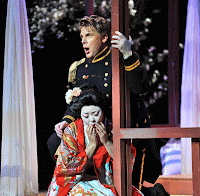The China doll stereotype root in the musical field quite deep too. It make its appearances in the early 1900s, and have been inherited and adapted ever since. Here is two of the most controversy opera that exacerbated the stereotype.
Madame Butterfly
Madame Butterfly
Madame Butterfly is an opera with three acts by Giacomo Puccini. It was first performed in 1904, and setting in Japan. It is the story of a
Japanese maiden (Cio-Cio San), who falls in love with and marries a white
American navy lieutenant. After the officer leaves her to continue his naval
service away from Japan, Cio-Cio San gives birth to their child. Cio-Cio San loyally
awaits the lieutenant's return, unaware that he already married to a Japanese woman. He
later discovered that he has a child with Cio-Cio San. He decide to go back to Japan and take the kid, then raise him with his American wife. The poor Japanese girl killed herself because of heartbroken (Madama Butterfly Synopsis).There has been much controversy about the opera, especially its sexist and
racist themes, which is female Easterner sacrificing love and life for the male Westerner. The author of the play claim that Madame Butterfly is developed by real life story. And it is true, only the one who committed suicide is the American navy, not Cio-Cio San. Ironically, it ranks as number 7 in the Operabase list of the most-performed operas worldwide. In the fact, it is a major hit that will perform at the LA Opera later this year. The fact that such a offensive opera is still widely performed all over the world would even intense the bad situation that Asian American females are already facing.
For whole opera, click here.
For whole opera, click here.
Miss Saigon
A
contemporary example would be Miss Saigon, a 1989 musical by
Claude-Michel Schönberg and Alain Boublil, a modern adaptation of Madame
Butterfly (TheBroadway Musical). The LA times called it "a celebration of stereotypes".Similar to Madame
Butterfly, the opera tells the tragic tale of a doomed romance involving an
Asian woman abandoned by her American lover. The setting of the plot is
relocated to the 1970s Saigon during the Vietnam War. In Madame Butterfly, the marriage is between an American lieutenant and Japanese girl. It is replaced by a romance between an American GI and a Vietnamese bar girl in Miss Saigon. As of January 2013, Miss Saigon is still the eleventh longest-running Broadway musical in musical theatre history (Long Runs on Broadway). This musical
has received a lot of criticism because it again portrayed Asian women as "virginal prostitutes" and as subservient. There is a
protest regarding its portrayal of East Asian men and women in 1995 in the Paramount Theatre. There was 25 shout, sign-carrying protesters argued that the show exploits Asian stereotypes. Miss Saigon has a history of protest. Its original London production
in 1989 was picketed for using non-Asian actors in Asian roles (seattletimes). The reason why people Asian start to fight back is that they realized stereotypes like this promote racism and sexism, and can lead to more oppression and violence in the long run.
The Asian woman is portrayed as delicate, shy, subservient, quiet, alluring, and faithful in the musical. The play writers let the Asian woman be the excellent love interest, but not as a wife or long-term partner (one need a white woman in that role after all). Although there are some effort, the racial and sexual stereotypes Westerners hold about Eastern culture still remains powerful and wrenching.
The Asian woman is portrayed as delicate, shy, subservient, quiet, alluring, and faithful in the musical. The play writers let the Asian woman be the excellent love interest, but not as a wife or long-term partner (one need a white woman in that role after all). Although there are some effort, the racial and sexual stereotypes Westerners hold about Eastern culture still remains powerful and wrenching.






